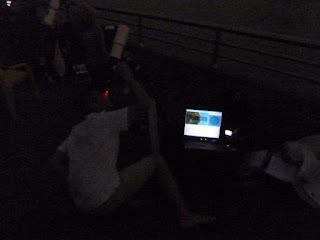Tomorrow is the day for departure. I stopped fooling around with equipment a couple of days ago and have been weighing and planning how to get everything down under. Thanks to the travel agency that I work for my baggage allocation has been increased. That helps, but the task still isn't easy. Here are the numbers for what is allowed:
A few days ago I did a rough weighing and found to my great relief that when all equipment was included I still had 4 kg left for personal items such as clothes and toothbrush. Whew - no problem!! I can live with that. A tube a wash detergent for travel use will come along.
Still, I do have some problems. I am concerned about fragile optical components: H-alpha filter, telescopes, eyepieces. These alone weigh more than 10 kg that I am allowed to carry on board. So here comes my little secret: in my jacket I will fill all pockets with little, heavy and fragile items - total weight of jacket is 5 kg! I'll be wearing this jacket while checking in - nobody will notice. Don't tell anyone. On the carry-on bag I am 2kg overweight and hope that it won't be weighed or that I can gain sympathy in the name of science if discovered.
Now, I just hope that I haven't forgotten anything!
- Checked in: 32 kg, one bag (normally only 23 kg)
- Carry on: 10 kg, one bag (normally only 7 kg)
A few days ago I did a rough weighing and found to my great relief that when all equipment was included I still had 4 kg left for personal items such as clothes and toothbrush. Whew - no problem!! I can live with that. A tube a wash detergent for travel use will come along.
Still, I do have some problems. I am concerned about fragile optical components: H-alpha filter, telescopes, eyepieces. These alone weigh more than 10 kg that I am allowed to carry on board. So here comes my little secret: in my jacket I will fill all pockets with little, heavy and fragile items - total weight of jacket is 5 kg! I'll be wearing this jacket while checking in - nobody will notice. Don't tell anyone. On the carry-on bag I am 2kg overweight and hope that it won't be weighed or that I can gain sympathy in the name of science if discovered.
Now, I just hope that I haven't forgotten anything!
| 38 kg of astro gear! |













